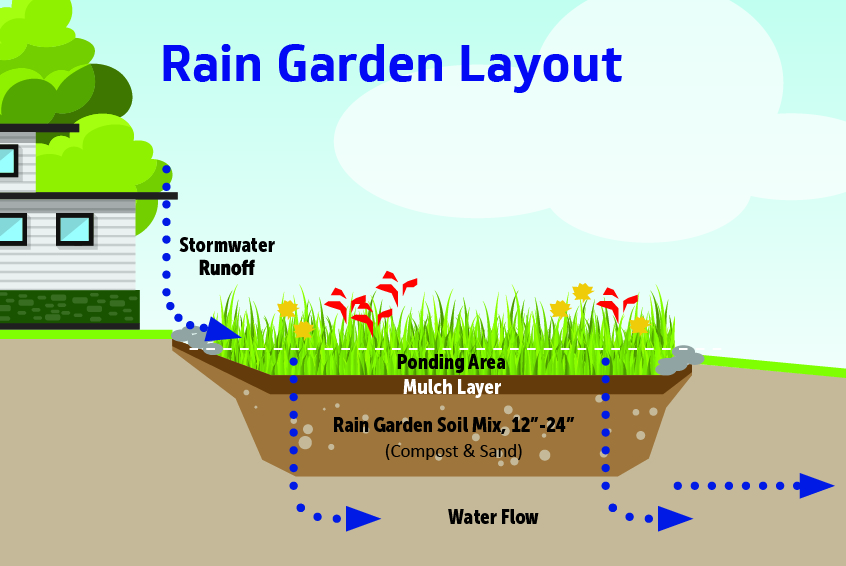Rain gardens are shallow depressions that are planted with deep-rooted native and non-native adaptive plants and grasses. They’re great for collecting water that runs off of rooftops or lawns. Rain gardens capture the runoff water, allowing it to soak into the ground. This recharges groundwater and naturally filters out pollutants. Plus, they can be a beautiful addition to your home.
5 steps for creating a rain garden
1. Pick the spot
- Contact local utilities by calling 811 to have them mark locations of underground wires, cables, or pipes.
- A rain garden should be at least 10 feet from foundations and fence posts, and 25 feet from septic system drain fields and well heads.
2. Outline the garden and determine depth
- The average size of a home rain garden is 70 square feet (7 x 10 feet), but the size can vary based on how much water you want to catch.
- Gardens should be no more than 6 to 12 inches deep.
- Make sure the garden is not flat because you need a depression to capture water.
3. Select the plants
- Select Florida native and non-native adaptive plants that can tolerate “wet feet” in the lowest places.
- Contact your County UF/IFAS Extension office for suggestions on plants suited to your location.
- Determine how many plants are needed based on your rain garden size and the mature plant dimensions.
Related: How to Make Your Backyard Friendly for Native Florida Wildlife
4. Dig in
- The depression should be marked and dug to the depth you determined in Step 2.
- Without a depression, the rain garden will not work.
- Make sure not to compact the soil – this is the leading cause of failed gardens
- Place each plant at its minimum distance from other plants
5. Finish up
- Install mulch or sphagnum moss to keep weeds out and retain moisture.
- Water the garden each day for the first week, and then gradually reduce watering over the next three weeks. After a month, normal rain should be enough to keep plants healthy.
- Regular maintenance is required to keep your rain garden looking good and functioning well.
Tips on how to manage your rain garden
Don’t worry about mosquitoes. The area should not retain water long enough for mosquitoes to have an opportunity to breed. You can direct your downspout to the rain garden by digging a shallow swale or by routing it through a drainpipe. If your soil lacks organic material, you may dig the depression an additional 2 to 3 inches and fill in with peat moss or compost.
If you are interested in creating a rain garden, contact Environmental Services Sustainable Water Resources at (813) 744-5671 or the UF/IFAS Extension, Hillsborough County, at (813) 744-5519 for more information.




























